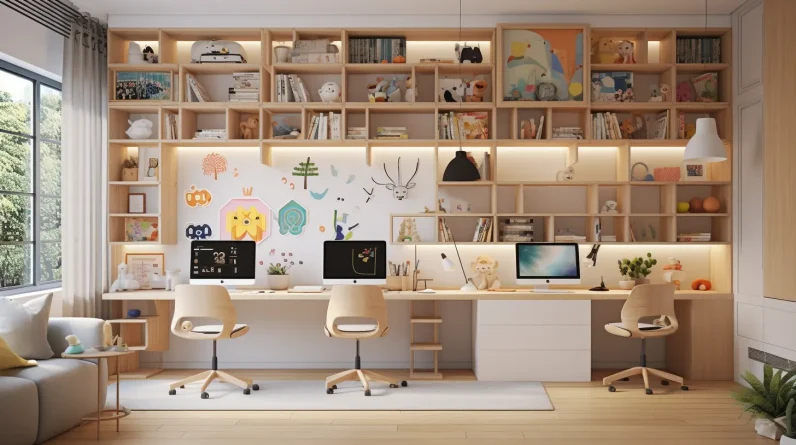
‘Home is where the heart is, and for children, it’s also where the mind grows. Establishing a dedicated study area for your child can drastically enhance their academic performance.
This article will guide you through the essential steps to create, maintain, and improve an efficient study space that fosters learning, creativity, and productivity. Let’s embark on this journey to develop a smart study haven, an investment in your child’s educational success and intellectual freedom.’
Key Takeaways
– A dedicated study space enhances a child’s ability to focus and absorb information.
– Proper lighting, comfortable furniture, and personalization are key elements for a child’s study area.
– Maintaining a clean and organized environment promotes focus and efficiency.
– The study area should evolve with the child’s growth and changing needs, incorporating technology as it evolves.
Understanding the Importance of a Dedicated Study Space
A considerable amount of research indicates that a dedicated study space significantly enhances a child’s ability to focus and effectively absorb information. This learning environment, crafted with care and attention, can turn into a productive haven for young minds.
Space customization plays an integral role in creating such an environment. Children, being the imaginative beings they are, not only crave but thrive in spaces that resonate with their personalities and learning styles. From choosing a desk with ample storage space to selecting the right lighting, each element contributes to a conducive learning environment.
The freedom to customize their own space also empowers children to take ownership of their learning journey. It fosters a sense of responsibility and enhances their ability to manage their study routines effectively.
A well-organized study space free from distractions promotes better concentration and improves academic performance. It also encourages children to explore their interests and discover new ways of learning.
Key Elements to Include in Your Child’s Study Area
In creating an effective study area for your child, it is crucial to consider key elements such as proper lighting and functional furniture, and also ensure it is a space that resonates with their personal learning style.
Lighting Essentials are not merely for illumination, but also play a significant role in maintaining your child’s focus and reducing eye strain. Ambience plays a crucial role too; hence, the use of soft, neutral light is often recommended.
Space Personalization is the next critical aspect. Remember, this is your child’s haven where they will be spending considerable time. Therefore, it should reflect their personality and interests. Incorporate their favorite colors, perhaps through wall art or study supplies, and allow them the freedom to arrange their space in a way that makes them comfortable and motivated. Accommodate their favorite books or educational toys to ensure a blend of learning and play.
The furniture should be functional yet comfortable, encouraging good posture and productivity. A height-adjustable desk and chair, ample storage for study materials, and a quiet environment can significantly enhance the study experience.
In essence, the goal is to create a child-centric space that fosters learning while keeping their comfort in mind.
Steps to Setting Up a Productive Study Space For Your Child
Five crucial steps to setting up a productive study space for your child include:
1. Choosing the right location: Despite space limitations, the right location is essential. Choose a tranquil area away from distractions but within reach for supervision.
2. Ensuring proper lighting: Proper lighting is a key factor in reducing eye strain. Opt for natural light if possible, supplemented with task lighting.
3. Selecting comfortable and functional furniture: When it comes to furniture, comfort and functionality should go hand-in-hand. Multifunctional furniture is a wise investment, particularly for small spaces.
4. Personalizing the space: In creating a unique study area, personalize the space according to your child’s preferences. Infuse elements of their interests to make it more appealing. Consider their age and the nature of their studies in the design.
5. Maintaining an organized environment: Maintain a clean and organized environment to promote focus and efficiency.
Smart Ways to Maintain and Improve the Study Area Over Time
Regularly tidying up and reevaluating the set-up of your child’s study area is a smart way to maintain its functionality over time and improve its efficacy. Space optimization is key for continued productivity; it involves regularly reviewing the study environment to ensure it is clutter-free, inviting, and conducive to focused learning. It also includes reorganizing the space to suit your child’s changing needs and preferences, fostering a sense of ownership and responsibility in them.
Tech incorporation is another essential aspect for maintaining an efficient study area. As technology evolves, it’s important to adapt and integrate beneficial tech tools. This could range from simple organizational apps to more advanced interactive learning platforms. However, it is crucial to strike a balance and ensure that technology enhances, not hinders, your child’s learning process.
An effective study area is not static; it evolves with your child’s growth. Freedom to explore, make modifications, and take ownership is what makes this space truly theirs. In this way, you are not just creating a study area, but a haven for intellectual curiosity and personal development.
Frequently Asked Questions (FAQs)
What Are Some Fun and Engaging Ways to Make the Study Area Interesting for My Child?
Integrating color psychology can make the study area more engaging. Use vibrant colors to stimulate creativity and calm tones for focus. Incorporate sensory stimulating elements like textured rugs or fidget tools for active learners.
How Can I Incorporate My Child’s Hobbies and Interests Into the Design of the Study Area?
Incorporating a child’s hobbies into a study area can be achieved through hobby-inspired furniture and theme-based decor. Choose desks, chairs, and decorative items that reflect their interests, fostering an engaging learning environment.
Are There Any Recommended Study Aids or Tools That Can Help My Child Focus Better?
Yes, incorporating digital distractions management tools like website blockers can enhance focus. Additionally, sensory tools integration, such as fidget toys or noise-cancelling headphones, can help create a more conducive learning environment for your child.
What Are Some Cost-Effective Ways to Set up a Smart Study Area?
Effective space utilization and budget planning are crucial. Consider multi-purpose furniture, second-hand items, and natural lighting. Utilize walls for storage and display of educational materials. Prioritize a quiet, comfortable area promoting focus and creativity.
Can the Study Area Be Multi-Purpose, Like for Arts and Crafts, or Should It Be Solely for Studying?
A study area can indeed be multi-purpose, accommodating both academic and artistic pursuits. However, space limitations and furniture choices must be carefully considered to maintain an organized and distraction-free environment for effective learning.
Conclusion
In conclusion, cultivating a well-structured and efficient study area for children can significantly improve their learning experience and academic performance.
While initial setup requires effort, the benefits of a disciplined, organized environment far outweigh the investment.
Any reservations about space or resource limitations can be alleviated by creative, multi-functional solutions.
The impact of such a dedicated space on a child’s development and success is immeasurable and enduring.







